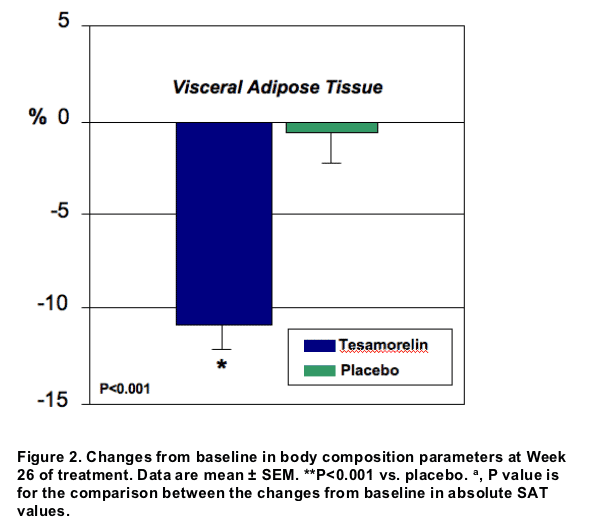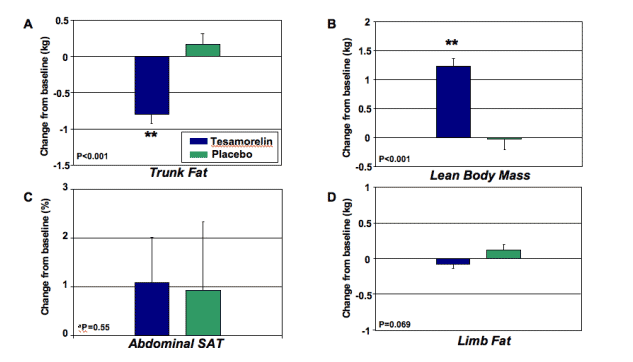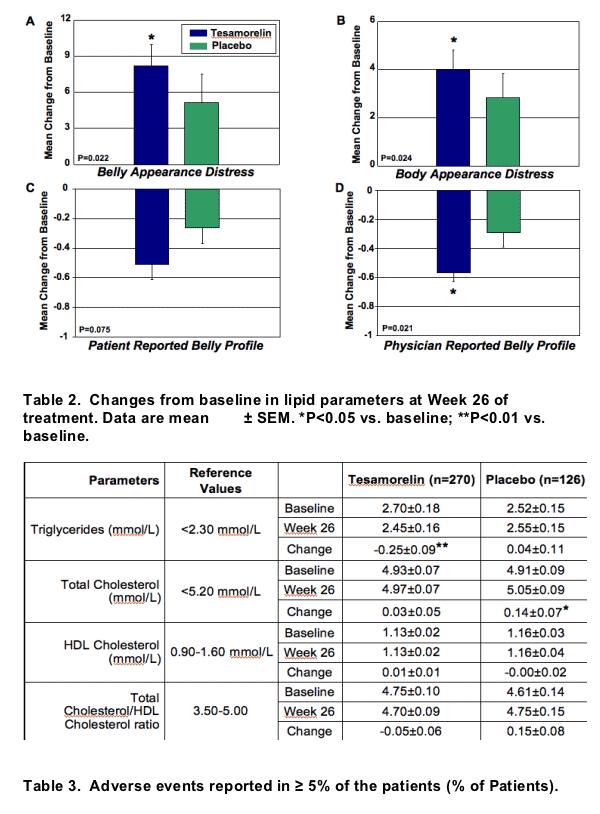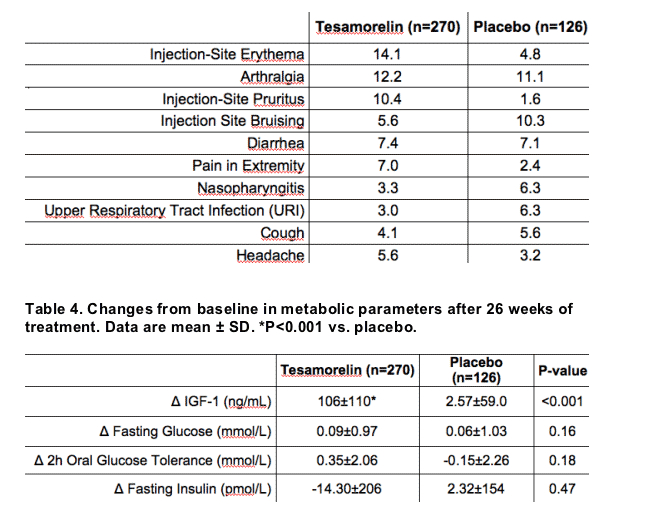 |
 |
 |
| |
Results from the 26-week Confirmatory, Phase 3 Trial of Tesamorelin (TH9507), a Growth Hormone-Releasing Factor Analogue, in HIV Patients with Excess Abdominal Fat: A Multicenter, Double-blind, Placebo-controlled Study with 404 Randomized Patients
|
| |
| |
Reported by Jules Levin
IAC Aug 3-8 2008 Mexico City
Julian Falutz1, Christian Marsolais2, Soraya Allas2, Diane Potvin2, Jean-Claude Mamputu2, Monika Zoltowska2, Daniel Berger3, Michael Somero4, Graeme Moyle5, Stephen Brown6, Claudia Martorell7, Ralph Turner8, and Steven Grinspoon9
1Montreal General Hospital, McGill University Health Centre, Montreal, Canada; 2Theratechnologies Inc., Montreal, Canada; 3Northstar Health Care, Chicago, IL, USA; 4Palm Springs, CA, USA; 5Chelsea and Wesminster Hospital, London, UK; 6AIDS Research Alliance, West Hollywood, CA, USA; 7The Research Institute, Springfield, MA, USA; 8Phase V Technologies Inc., Wellesley, MA, USA, 9Massachusetts General Hospital and Harvard Medical School, Boston, MA, USA
"preferentially decreases VAT, and improves belly image.... Mean IGF-1 levels increased within the physiological range in tesamorelin-treated patients"
ABSTRACT
Background: HIV patients receiving antiretroviral therapy (ART) often show increased visceral adipose tissue (VAT), a known cardiovascular risk factor. Excess VAT may have a negative impact on body image, resulting in non-adherence to ART. Treatment with tesamorelin was overall well tolerated and resulted in sustained VAT loss in the first Phase 3 trial in HIV patients. Here are presented key 26-week results of the confirmatory trial.
Method: HIV patients (84% male) with evidence of excess abdominal fat accumulation in the context of ART were randomized to 2 mg tesamorelin (n=275) or placebo (n=129) s.c. daily for 26 weeks. The primary endpoint was the percent change in VAT. Secondary endpoints included patient-reported outcomes related to body image, triglycerides, total cholesterol/HDL ratio, IGF-1, and safety.
Results:
Baseline age was 48±8 [mean±SD] years and waist circumference 105±9 cm. At Week 26, VAT significantly decreased in tesamorelin-treated patients over placebo (-10.9±21.2 vs. -0.6± 18.9%, P<0.001).
Changes in abdominal subcutaneous adipose tissue (SAT) were not significantly different between groups (1.1±15.2 vs. 0.9±15.8%, tesamorelin vs. placebo, P=0.55).
Treatment with tesamorelin was associated with significant improvements in belly appearance distress (P=0.022 vs. placebo) and physician-reported belly profile (P=0.021 vs. placebo).
A trend for improvement in triglycerides was observed in tesamorelin-treated patients (change from baseline: -0.25±1.48 vs. 0.04±1.20 mmol/L, tesamorelin vs. placebo, P=0.08 vs. placebo and P=0.01 vs. baseline), while no significant changes were observed in the total cholesterol/HDL ratio.
Mean IGF-1 levels increased within the physiological range in tesamorelin-treated patients (change from baseline: 106±110 ng/mL, P<0.001 vs. placebo).
Finally, treatment was overall well tolerated, with no significant changes in glucose parameters.
Conclusion: These data confirm that daily administration of 2 mg tesamorelin for 26 weeks to HIV patients with excess abdominal fat accumulation is overall well tolerated, preferentially decreases VAT, and improves belly image, which may have important implications for HIV treatment
INTRODUCTION
HIV patients treated with antiretroviral therapy (ART) often demonstrate HIV lipodystrophy, which is characterized by body changes, such as fat accumulation in the abdomen (lipohypertrophy) and metabolic abnormalities including dyslipidemia and/or insulin resistance (1). Accumulating evidence indicate that these patients are at increased risk of cardiovascular diseases (2, 3). Moreover, excess abdominal fat has been shown to have a negative impact on body image, which often results in non-adherence to ART. Previous results from a first 52 weeks Phase 3 study clearly demonstrated that administration of tesamorelin (TH9507), a stabilized analogue of growth hormone-releasing factor (GRF), to HIV-infected patients with lipohypertrophy was generally well tolerated and resulted in significant improvements in visceral adipose tissue (VAT), triglyceride levels and patient-reported outcome related to body image at Week 26 and sustained effects at Week 52 with continued treatment (4-6). Here we report the data from the 26 weeks Phase 3 study aimed at confirming the results of the main phase of the first Phase 3 study.

OBJECTIVES
Primary: To demonstrate a reduction in VAT from baseline vs. placebo by computerized tomographic (CT) scan at L4-L5.
Secondary: To demonstrate the efficacy of tesamorelin vs. placebo in: (i) patient reported outcomes related to body image, (ii) total cholesterol/HDL-cholesterol ratio and triglycerides levels, and (iii) serum IGF-1 levels. To characterize the safety profile of tesamorelin (glucose, insulin, adverse events and others).
STATISTICAL ANALYSIS
The efficacy endpoints were analyzed using an analysis of covariance (ANCOVA) model, including baseline as a covariate, on ITT (intent-to-treat) population, with LOCF (last observation carried forward) analysis, to determine treatment differences between tesamorelin and placebo. Within treatment comparisons were performed using Student paired t-test. The study had 90% statistical power to detect an 8% difference in VAT (% change) between tesamorelin and placebo. Evaluation of safety at Week 26 of treatment was based on the safety population.
RESULTS



Figure 3. (A) Changes from baseline in belly appearance distress, and (B) Composite body appearance distress. Body appearance distress was scored from 0 (extremely upsetting) to 100 (extremely encouraging), a positive change indicating an improvement. (C) Patient self-reported belly profile and (D) Physician reported belly profile. Belly profiles were scaled from 0 (Normal) to 5 (Largest belly), a negative change indicating an improvement. Data are mean ± SEM. *P<0.05 vs. placebo.


CONCLUSIONS
These results confirm that daily s.c. administration of 2 mg tesamorelin for 26 weeks to HIV patients with excess abdominal fat: (i) significantly decreases VAT, without affecting SAT, (ii) significantly improves belly image, (iii) improves triglyceride levels, and (iv) is overall well tolerated without significant clinical effect on glucose parameters. Taken together, these results confirm previous data suggesting that tesamorelin may be beneficial for the treatment of HIV patients with lipohypertrophy.
References:
1. Grinspoon and Carr. N Engl J Med. 2005;352: 48-62
2. Hadigan et al. Clin Infect Dis. 2001;32: 130-39
3. Wohl et al. 15th Conference on Retroviruses and Opportunistic Infections, Boston, USA, February 3-6, 2008 (Abstract #956)
4. Falutz et al. N Engl J Med. 2007;357: 2359-70
5. Falutz et al. 11th European AIDS Conference/EACS, Madrid, Spain, October 24-27, 2007 (Abstract #LBPS7/3)
6. Falutz et al. 15th Conference on Retroviruses and Opportunistic Infections, Boston, USA, February 3-6, 2008 (Abstract #943)
|
| |
|
 |
 |
|
|